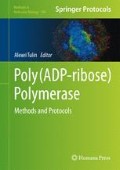Abstract
Poly(ADP-ribosyl)ation is a post-translational modification of proteins mediated by Poly(ADP-ribose) polymerases (Parps), a family of 17 members. Among them, Poly(ADP-ribose) polymerase-1 (Parp-1) and Parp-2 are so far the sole enzymes whose catalytic activity has been shown to be induced by DNA strand breaks. The generation and characterization of Parp-1 and Parp-2 deficient cellular and animal models have largely contributed to describe both proteins as active players of the base excision repair/single-strand break repair (BER/SSBR) process with both redundant and more specific functions. Double Parp-1−/−Parp-2−/− embryos die at gastrulation demonstrating the crucial role of poly(ADP-ribosyl)ation during embryonic development, whereas a specific female lethality related to X chromosome instability is associated with the Parp-1+/−Parp-2−/− genotype. Finally, recent research discovered emerging unique functions of Parp-2 in physiological processes including spermatogenesis, T-cell maturation, and adipogenesis although with distinct mechanisms. In this chapter, we describe standard operating procedures used to genotype and phenotype both mouse lines and the derived mouse embryonic fibroblasts.
Access this chapter
Tax calculation will be finalised at checkout
Purchases are for personal use only
References
Schreiber V, Dantzer F, Ame JC, de Murcia G (2006) Poly(ADP-ribose): novel functions for an old molecule. Nat Rev Mol Cell Biol 7:517–528
Yelamos J, Schreiber V, Dantzer F (2008) Toward specific functions of poly(ADP-ribose) polymerase-2. Trends Mol Med 14:169–178
Chalmers A, Johnston P, Woodcock M, Joiner M, Marples B (2004) PARP-1, PARP-2, and the cellular response to low doses of ionizing radiation. Int J Radiat Oncol Biol Phys 58:410–419
Menissier de Murcia J, Ricoul M, Tartier L, Niedergang C, Huber A, Dantzer F, Schreiber V, Ame JC, Dierich A, LeMeur M, Sabatier L, Chambon P, de Murcia G (2003) Functional interaction between PARP-1 and PARP-2 in chromosome stability and embryonic development in mouse. EMBO J 22:2255–2263
Dantzer F, Giraud-Panis MJ, Jaco I, Ame JC, Schultz I, Blasco M, Koering CE, Gilson E, Menissier-de Murcia J, de Murcia G, Schreiber V (2004) Functional interaction between poly(ADP-Ribose) polymerase 2 (PARP-2) and TRF2: PARP activity negatively regulates TRF2. Mol Cell Biol 24:1595–1607
Gomez M, Wu J, Schreiber V, Dunlap J, Dantzer F, Wang Y, Liu Y (2006) PARP1 is a TRF2-associated poly(ADP-ribose)polymerase and protects eroded telomeres. Mol Biol Cell 17:1686–1696
Saxena A, Wong LH, Kalitsis P, Earle E, Shaffer LG, Choo KH (2002) Poly(ADP-ribose) polymerase 2 localizes to mammalian active centromeres and interacts with PARP-1, Cenpa, Cenpb and Bub3, but not Cenpc. Hum Mol Genet 11:2319–2329
Saxena A, Saffery R, Wong LH, Kalitsis P, Choo KH (2002) Centromere proteins Cenpa, Cenpb, and Bub3 interact with poly(ADP-ribose) polymerase-1 protein and are poly(ADP-ribosyl)ated. J Biol Chem 277:26921–26926
Meder VS, Boeglin M, de Murcia G, Schreiber V (2005) PARP-1 and PARP-2 interact with nucleophosmin/B23 and accumulate in transcriptionally active nucleoli. J Cell Sci 118:211–222
Dantzer F, Mark M, Quenet D, Scherthan H, Huber A, Liebe B, Monaco L, Chicheportiche A, Sassone-Corsi P, de Murcia G, Menissier-de Murcia J (2006) Poly(ADP-ribose) polymerase-2 contributes to the fidelity of male meiosis I and spermiogenesis. Proc Natl Acad Sci U S A 103:14854–14859
Bai P, Houten SM, Huber A, Schreiber V, Watanabe M, Kiss B, de Murcia G, Auwerx J, Menissier-de Murcia J (2007) PARP-2 controls adipocyte differentiation and adipose tissue function through the regulation of the activity of the RXR/PPARgamma heterodimer. J Biol Chem 282:37738–37746
Yelamos J, Monreal Y, Saenz L, Aguado E, Schreiber V, Mota R, Fuente T, Minguela A, Parrilla P, de Murcia G, Almarza E, Aparicio P, Menissier-de Murcia J (2006) PARP-2 deficiency affects the survival of CD4+CD8+ double-positive thymocytes. EMBO J 25:4350–4360
Robert I, Dantzer F, Reina-San-Martin B (2009) Parp1 facilitates alternative NHEJ, whereas Parp2 suppresses IgH/c-myc translocations during immunoglobulin class switch recombination. J Exp Med 206:1047–1056
de Murcia JM, Niedergang C, Trucco C, Ricoul M, Dutrillaux B, Mark M, Oliver FJ, Masson M, Dierich A, LeMeur M, Walztinger C, Chambon P, de Murcia G (1997) Requirement of poly(ADP-ribose) polymerase in recovery from DNA damage in mice and in cells. Proc Natl Acad Sci USA 94:7303–7307
Author information
Authors and Affiliations
Editor information
Editors and Affiliations
Rights and permissions
Copyright information
© 2011 Springer Science+Business Media, LLC
About this protocol
Cite this protocol
Boehler, C., Gauthier, L., Yelamos, J., Noll, A., Schreiber, V., Dantzer, F. (2011). Phenotypic Characterization of Parp-1 and Parp-2 Deficient Mice and Cells. In: Tulin, A. (eds) Poly(ADP-ribose) Polymerase. Methods in Molecular Biology, vol 780. Humana Press, Totowa, NJ. https://doi.org/10.1007/978-1-61779-270-0_19
Download citation
DOI: https://doi.org/10.1007/978-1-61779-270-0_19
Published:
Publisher Name: Humana Press, Totowa, NJ
Print ISBN: 978-1-61779-269-4
Online ISBN: 978-1-61779-270-0
eBook Packages: Springer Protocols

